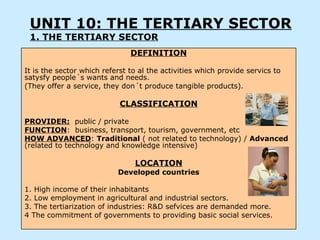
Tertiary sector
- 1. UNIT 10: THE TERTIARY SECTOR 1. THE TERTIARY SECTOR DEFINITION It is the sector which referst to al the activities which provide servics to satysfy people´s wants and needs. (They offer a service, they don´t produce tangible products). CLASSIFICATION PROVIDER: public / private FUNCTION: business, transport, tourism, government, etc HOW ADVANCED: Traditional ( not related to technology) / Advanced (related to technology and knowledge intensive) LOCATION Developed countries 1. High income of their inhabitants 2. Low employment in agricultural and industrial sectors. 3. The tertiarization of industries: R&D sefvices are demanded more. 4 The commitment of governments to providing basic social services.
- 2. 2. OUTSOURCING • Sometimes, the location of the provider is not important. In those cases, developed countries often transfer some of their services to less developed countries where labour force is cheaper. • India: it is a country which has especially benefited from the outsourcing of western services= low labour costs + avalilability of wokers with expertise in new technologies and fluency in English.
- 3. 3. TRANSPORT SERVICES TRANSPORT • Movement of people and goods from one place to another after the combiantion of many human and material elements: • Different vehicles used fo travel (Modes of transport) : car, train, plane or boat. • Elements necessary for transport (infrastructure) : roads, railways, airports, ports... (telephone lines are also considered transport infrastructure). IMPORTANCE OF TRANSPORT: It has been one of the fastest-growing tertiary activities in the past two years. Reasons: industrialization, increase in tarde and travel and technical advances (greater speed, capacity, safety, lower costs...) FUNCTIONS Economic: it allows the exchange of goods and the everyday travel of the population (outsourcing). Political: It reinforces the integration of the different regions and areas in a territory. Social: it facilitates human relation and activities (leisure, learning cultures...)
- 4. • TRANSPORT NETWORK: it is the infrastruture which is necessary for vehicles to circulate: series of nodes (cities, stations...) + axes / lines (connect the nodes)
- 5. 4. TRANSPORT SYSTEMS • Road Transport: used for personal travel (over short distances) and transporting goods. + no fixed routes - more accidents than any other type of transport • Rail Transport: carry passenger (short and medium-range distances). Also used for carrying large and heavy loads. + large volume of goods can be carried. - restrictes to places connected by railway tracks = fxed routes • Water Transport: sea and river transport (navigable). Used for personal travel and transporting goods. + cheap - inattractive for long-distance passenger travel - requires ports with facilities for ships and cargo - water pollution (oil spills) • Air Transport: Used for long distances transport of passengers and goods of limited volume. + speed - severe environmental impacts from noise and pollution - high fuel consumption - airport infrastructure is necessary for operation
- 6. 5. WHAT IS TRADE? • Trade is the exchange of goods and services. • In many countries, it is the most important type of service in terms of turnover and the number of wprkers employed. FACTORS: - Transport and infrastructure development (cities have the best communications) - Market size: if the market (nº of consumers who can buy goods or services) is bigger, there is more trade. - Population´s wealth: if people have a high economical level, thwy will consume more. TYPES OF TRADE: - Domestic trade: it takes place within a country´s borders. - Foreign trade: it takes place with other countries.
- 7. BALANCE OF TRADE It is the difference between the value of a country´s exports and the value of its imports. Positive balance: If the value of the exports is more than the value of its imports. (favourable) Negative balance: If the value of the imports is less than the value of its exports. (unfavourable) MAJOR TRADE FLOWS The developed countries control most of the world´s trade. Developing countries have significantly increased their share in world goods trade. However, a large number of less developed countries, especially in Africa and the Midle East, remain outside the world trade flows.
- 8. 6. WHAT IS TOURISM? • Tourism consists of the activities people do for pleasure during their travels. • It is considered a contemporary phenomenon. Until the mid-twentieth century, tourism was limited to wealthy people and took place mostly in coastal areas, spas and health resorts. • In 1950s, developed countries experienced a period of high economic growth, and it became a mass phenomenon. Since then, the number of tourists has grown steadily. • THE GROWTH OF TOURISM - Higher income levels. People have more money to spend. - Improved transport. This reduce costs and time. - More lisure time. People have more days off and paid holidays. - Diversification. More options are offered (hotels, rural houses, campsites…) - Specialized companies. Tour operators and travel agencies create travel packages and promote new destinations. - Simple or no border formalities.
- 9. •Positive effects: -The increase in wealth of receiving countries. -Activation of the economy and labour market. -The improvement and construction of infrastructure. -New economic opportunities in rural areas. •Negative effects: -Regional economic imbalances. -Seasonal and precarious employment. -Environmental impact. Iternational tourist flows: Developed countries are the source of almost all type of the tourists who cross the border of any country. Today there are neraly 900 million tourists, with great variety of destinations.
